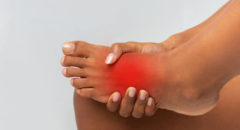
A plantar fibroma is a benign (non-cancerous) growth that develops within the plantar fascia, the thick band of tissue running along the bottom of the foot. The plantar fascia connects your heel bone to your toes and supports the arch of the foot. When a plantar fibroma forms, it appears as a small lump or nodule, typically embedded deep in the tissue, often in the middle of the arch. While the growth itself is non-malignant, it can cause discomfort or pain, particularly when walking or standing for extended periods.
Causes of Plantar Fibroma
The exact cause of plantar fibromas is not well understood. However, some contributing factors may include:
- Genetics: There seems to be a hereditary predisposition, as the condition can sometimes run in families.
- Injury: Trauma or repetitive stress to the plantar fascia may trigger the development of a fibroma.
- Medical Conditions: Conditions such as diabetes, liver disease, and certain autoimmune disorders may increase the likelihood of developing fibromas.
- Medications: The use of medications such as beta-blockers has been linked to the development of fibromas, though this is rare.
Symptoms of Plantar Fibroma
The most prominent symptom of a plantar fibroma is a noticeable lump in the arch of the foot. The nodule is usually firm to the touch and may vary in size. While many individuals may not experience any symptoms other than the lump, others may encounter:
- Pain or Discomfort: Particularly when walking or standing, the fibroma can press against the surrounding tissues or bones, causing discomfort. The pain often worsens when wearing tight or unsupportive shoes.
- Swelling: In some cases, swelling can occur around the affected area.
- Difficulty with Foot Function: The presence of a plantar fibroma can alter the way weight is distributed across the foot, leading to discomfort or awkward movement.
Diagnosis of Plantar Fibroma
To diagnose a plantar fibroma, a healthcare provider will typically perform a physical examination of the foot, feeling for the lump and assessing its size and firmness. They may also inquire about your symptoms, such as pain or difficulty walking.
In some cases, imaging tests such as an MRI (Magnetic Resonance Imaging) or ultrasound may be ordered to better understand the size, location, and depth of the fibroma. These tests help to rule out other potential causes of foot pain or lumps, such as cysts, tumors, or infections.
Treatment Options for Plantar Fibroma
Treatment for plantar fibromas depends on the size of the fibroma, the severity of symptoms, and the level of discomfort. Several treatment options are available, ranging from conservative approaches to more invasive procedures:
- Conservative Treatments:
- Orthotic Inserts: Custom or over-the-counter shoe inserts can help redistribute weight away from the fibroma, reducing pressure on the nodule and alleviating pain.
- Stretching and Physical Therapy: Targeted exercises may help to ease tension in the plantar fascia and improve foot function.
- Steroid Injections: Corticosteroid injections can temporarily reduce inflammation and pain around the fibroma, though this is not a long-term solution.
- Anti-Inflammatory Medications: Over-the-counter pain relievers like ibuprofen can help manage symptoms but do not address the fibroma itself.
- Surgical Treatment:
- If conservative treatments fail to provide relief, surgery may be recommended. Surgical removal of the plantar fibroma (known as a plantar fasciectomy) involves excising the fibroma from the plantar fascia. This procedure carries some risk, including potential nerve damage, arch collapse, or the formation of additional fibromas.
Prognosis
For many people, a plantar fibroma remains relatively stable and causes minimal discomfort. Conservative treatments like orthotics and physical therapy can help manage symptoms in most cases. However, in cases where the fibroma continues to grow or causes significant pain, surgical intervention may be necessary. It is important to note that even after surgery, plantar fibromas have a tendency to recur.
Preventive Measures
While it is not always possible to prevent the development of a plantar fibroma, there are steps you can take to reduce your risk:
- Maintain Foot Health: Wearing supportive footwear, avoiding repetitive foot trauma, and stretching your feet regularly can help reduce strain on the plantar fascia.
- Manage Medical Conditions: If you have underlying conditions such as diabetes or liver disease, managing these conditions may help lower your risk of developing fibromas.
Plantar fibromas, though benign, can cause significant discomfort and affect daily activities. Early detection and treatment can help manage symptoms and improve foot function. For individuals experiencing ongoing pain or difficulty walking, consulting a healthcare professional is essential to receive appropriate care and treatment.
Understanding the nature of plantar fibromas allows individuals to make informed decisions about managing their condition and improving their quality of life.






